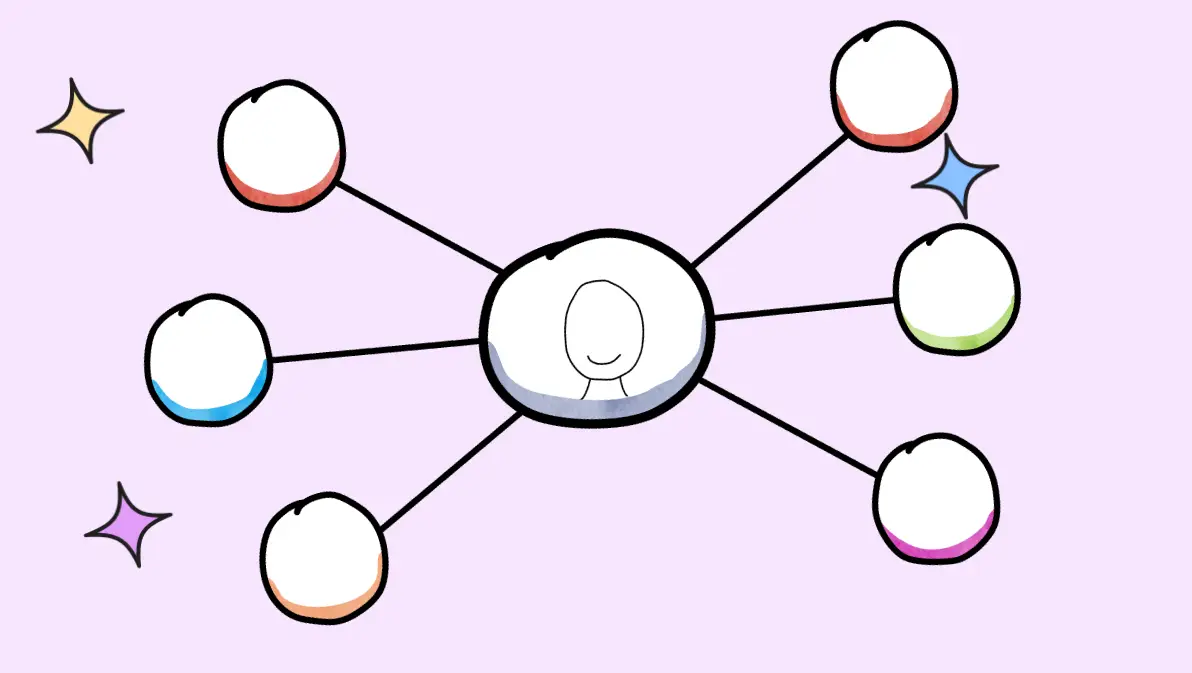Connectivism
Connectivism is a learning theory designed for the digital age. It recognizes that learning no longer happens only inside the mind. Today, it also happens across networks of people, platforms, and digital systems that constantly evolve.
Overview of Connectivism
Connectivism is often described as a learning theory for the digital age. It emerged in response to the limits of traditional theories like behaviorism, cognitivism, and constructivism, which were all developed before the internet reshaped how we access and share knowledge. Where those theories focused on internal processes or individual meaning-making, connectivism shifts the focus outward: learning is no longer something that just happens inside our heads, but something that also happens across networks, systems, and relationships.
In simple terms, connectivism sees learning as the ability to make connections between information sources, people, and ideas -and to keep those connections alive. Knowledge doesn't need to be stored and retrieved in the same way anymore, because we now have access to external systems (like Google, databases, or AI tools) that help us find and use information when we need it. What matters more is knowing where to find knowledge, how to evaluate it, and how to stay connected to the right sources over time.
This theory was developed by George Siemens (2004) and Stephen Downes, who argued that learning in the 21st century requires a new model, one that reflects how people interact in complex digital environments. Their ideas were shaped by network theory, chaos theory, and the rise of online learning communities. Connectivism doesn't reject previous theories but builds on them to explain learning that's social, digital, and constantly evolving.
Here are a few defining characteristics of connectivism:
- Learning happens across networks:
Not just in the individual mind, but through systems of people, platforms, and technologies. - Currency of knowledge matters:
Information changes fast. Staying connected to the latest and most reliable sources is key. - Diversity of opinions strengthens learning:
Exposure to multiple perspectives is seen as valuable, not something to eliminate. - Decision-making is part of learning:
The ability to recognise what information is important, and filter what's not, is a critical skill.
Unlike other theories, connectivism doesn't define learning as a change in behaviour or a shift in internal understanding. It's about navigating complexity, staying connected, and adapting continuously in a world where knowledge is always moving.
This theory also places a strong emphasis on digital literacy, not just knowing how to use tools, but being able to find, evaluate, and remix information from multiple sources. In a connectivist framework, digital literacy becomes a core competency. Learners need to think critically about the information they encounter, identify trustworthy sources, and manage how they interact with technology on a daily basis. It's not about memorising facts, it's about learning how to learn in a networked world.
Another key concept in connectivism is the Personal Learning Network (PLN). A PLN is the system of people, platforms, and tools that a learner builds over time to support ongoing learning. This might include colleagues, mentors, podcasts, online communities, or curated news feeds. The idea is that knowledge lives in these networks, and learning happens by engaging with them intentionally; connecting, contributing, and staying open to new input.
Connectivism is a relatively recent theory, shaped by two key contributors who responded directly to the challenges of learning in a digital world:
- 2004 - George Siemens
Introduced connectivism as a learning theory for the digital age, where learning happens across networks and access matters more than memorization. - 2005 - Stephen Downes
Expanded the theory by connecting it to network design and early MOOCs (Massive Open Online Courses), emphasising that knowledge is distributed and built through interaction.
Together, their work reframed learning as a connected, ongoing process, driven by relationships, digital tools, and participation across platforms.
"Connectivism is less about what you know and more about how you stay connected to what you need to know"
Connections to teaching and learning
Connectivism shifts how we think about both what we teach and how we support learners. It's not just about delivering content or guiding internal meaning-making. It's about designing opportunities for learners to build, grow, and maintain their own networks of knowledge.
That starts with recognizing that no single person or course can hold all the answers. Learners need to develop the ability to find information, filter it, evaluate it, and connect it with what they already know. That means instruction has to go beyond "here's the content". It has to ask, "Where can you find reliable information when this changes tomorrow?"
In practice, this might look like:
- Encouraging learners to follow thought leaders, blogs, or curated feeds in their field.
- Creating tasks that involve finding, comparing, and synthesising resources from outside the course itself.
- Having learners map their Personal Learning Network (PLN) or reflect on where they get their best ideas, tools, or inspiration.
Teaching from a connectivist perspective also means acknowledging that technology isn't just a delivery tool. It's part of the learning environment itself. Tools like discussion forums, collaborative documents, RSS feeds, and even AI tools become part of how knowledge is accessed, shared, and grown. It's our job as designers and educators to help learners use those tools intentionally.
Connectivism reminds us that learning is never finished. The goal isn't mastery in a static field, it's the ability to keep learning in a changing one. That's especially relevant in digital industries, fast-moving sectors, or any area where upskilling and adaptability are constant. Teaching with connectivism in mind means designing for that kind of learning future.
"Connectivism challenges us to design for growth that doesn't stop at course completion. It's about helping learners build the habits, tools, and networks they'll need to keep learning long after the module ends"
A Learning Theory for the Digital Age
Siemens introduced connectivism as a response to the limitations of earlier learning theories in explaining how people learn in a digital, networked world. He argued that knowledge is no longer something we just acquire internally, it's something we access, share, and grow through constantly evolving networks. His work laid the foundation for how we now think about online learning, lifelong learning, and learning as a connected process.

An Introduction to Connective Knowledge
Downes expanded Siemens' ideas by grounding them in network theory and online learning design. He focused on how knowledge is distributed across networks and how meaning is created through interaction. His work helped shape how educators think about building environments where learners can connect, curate, and create, not just consume, information. Downes also played a major role in early MOOC (Massive Open Online Courses) development, applying connectivist principles to large-scale learning experiences.


Implications of Connectivism for Instructional (Learning) Design
Connectivism has reshaped how I think about what it means to "design learning". It's no longer just about delivering the right information at the right time. It's about building the skills, habits, and digital environments that help learners stay connected to knowledge in the long term.
One of the biggest shifts is designing with the assumption that learners won't (and shouldn't) try to store everything. Instead, I think about how to help them find what they need, when they need it, and stay plugged into reliable sources. That might mean building in curated content feeds, resource hubs, or encouraging learners to follow experts in their field. It also means teaching them how to evaluate what they're finding, because not every connection is helpful.
From a design standpoint, I also pay more attention to networked tools and environments. Forums, Slack groups, peer review spaces, shared documents, these aren't just add-ons. They're part of the learning process. I'll often build tasks where learners have to research beyond the course, share findings with others, or reflect on what's influencing their thinking. The learning happens in those connections, not just in the content.
Connectivism also reminds me that learners are already learning informally all the time. The challenge isn't getting them to start, it's helping them become more intentional. So I try to design in ways that acknowledge this: by asking questions like, "Who do you follow on this topic?", "Where do you go for updates?", or "How do you keep your skills sharp in this area?"; Those answers become part of the learning experience too.
Instructionally, it means thinking less about completion and more about continuity. The goal isn't just to get learners through the course. It's to leave them better equipped to keep learning beyond it. That's a very different design goal, and one I've found incredibly valuable.
Strengths and Limitations of Connectivism
Corporate Training
Connectivism makes a lot of sense in today's corporate world, especially in fast-moving industries where information changes daily and continuous learning is the norm. It's built for environments where employees need to find answers quickly, adapt to change, and stay connected to evolving knowledge sources. But like any theory, it's not without its challenges.
Strengths
- It supports ongoing learning beyond the course. When learners are taught how to build and maintain their own Personal Learning Networks (PLNs), they're more likely to keep growing after the training ends.
- It's a great fit for modern workflows. Many roles already rely on tools like Slack, LinkedIn, shared drives, and peer networks. Connectivism acknowledges these tools as part of how learning actually happens on the job.
- It builds digital literacy and adaptability. These are core skills in any organisation dealing with change, innovation, or complex information.
- It encourages autonomy and critical thinking, as learners learn to filter sources, stay updated, and evaluate new information on their own.
Limitations
- It assumes a level of self-direction not all learners have. Some people expect clear instructions and structured content, and without that, they may feel lost or unsupported.
- It's harder to align with strict training outcomes. If a company needs everyone to complete the same learning path and demonstrate the same knowledge, the open-ended nature of connectivism can make that difficult.
- Measuring success is tricky. Because the focus is on network-building and long-term growth, it's not always easy to track what's been "learned" in a measurable, short-term way.
- It relies heavily on access to technology and digital fluency. Not every learner starts with the same tools, habits, or confidence online.
"Connectivism is powerful when the goal is growth in fast-moving, digital environments. But it's not a plug-and-play solution. It needs thoughtful design, support for different learning styles, and alignment with real organizational goals”
Summary
Connectivism
Connectivism is a learning theory built for the digital age—one that reflects how people actually learn in today's hyper-connected world. It moves away from the traditional idea of knowledge as something to be delivered, memorized, or stored in isolation. Instead, connectivism sees learning as a living, evolving process that happens across networks of people, digital tools, and information sources.
At the heart of this theory is a simple but powerful idea: knowledge exists in the connections themselves, not just in the individual. In practice, that means learning is no longer a solo activity. It's an ongoing exchange—through online communities, shared resources, and collaborative spaces—where we co-construct meaning and stay current by staying connected.
Digital Literacy
Digital literacy plays a crucial role in connectivist learning. But it's not just about knowing how to use apps or tools. It's about critically evaluating online content, solving problems using digital resources, and navigating digital spaces responsibly. In today's learning environments, instructional designers must go beyond technical training and help learners build digital confidence: how to search, filter, question, and apply knowledge in real time.
That includes teaching skills like:
- Spotting misinformation
- Synthesizing digital content
- Applying ethical judgment when engaging with technology
When combined with other essential skills, digital literacy helps learners adapt in a constantly shifting digital landscape.
Personal Learning Networks
Connectivism also reframes the idea of professional development. Instead of waiting for formal training, learners are encouraged to build Personal Learning Networks (PLNs)—self-driven systems of growth built around shared interests, platforms, and conversations. These networks might include thought leaders on LinkedIn, niche Slack groups, or online communities of practice.
The benefit? Continuous learning that's relevant, informal, and flexible. PLNs help learners:
- Tap into emerging ideas
- Stay current in fast-changing industries
- Engage in meaningful, two-way learning experiences with peers and experts
For instructional designers, integrating PLNs into learning ecosystems means creating space for curiosity, collaboration, and real-world relevance.
"In connectivism, learning isn't what you know. It's your ability to stay connected, filter wisely, and keep learning across the network"
Connectivism isn't about discarding everything we knew before. It's about responding to how learning actually happens now. With the rise of online platforms, AI tools, and social knowledge-sharing, learning is no longer linear. It's distributed, fluid, and deeply personal. And for today's learners and designers, that's both a challenge and an opportunity.
© Images from Wikimedia Commons in the public domain.


